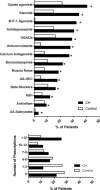Clinical Characteristics and Treatment Patterns Among Patients Diagnosed With Cluster Headache in U.S. Healthcare Claims Data
- PMID: 28581025
- PMCID: PMC5655925
- DOI: 10.1111/head.13127
Clinical Characteristics and Treatment Patterns Among Patients Diagnosed With Cluster Headache in U.S. Healthcare Claims Data
Abstract
Objective: To characterize demographics, clinical characteristics, and treatment patterns of patients with cluster headache (CH).
Background: CH is an uncommon trigeminal autonomic cephalalgia with limited evidence-based treatment options. Patients suffer from extremely painful unilateral headache attacks and autonomic symptoms with episodic and chronic cycles.
Design/methods: This retrospective analysis used insurance claims from Truven Health Analytics MarketScan® research databases from 2009 to 2014. Two cohorts were compared: CH patients (with ≥2 CH claims) were propensity score matched with 4 non-headache controls, all with continuous enrollment for 12 months before and after the date of first CH claim or matched period among controls.
Results: CH patients (N = 7589) were mainly male (57.4%) and 35-64 years old (73.2%), with significantly more claims for comorbid conditions vs controls (N = 30,341), including depressive disorders (19.8% vs 10.0%), sleep disturbances (19.7% vs 9.1%), anxiety disorders (19.2% vs 8.7%), and tobacco use disorders (12.8% vs 5.3%), with 2.5 times greater odds of suicidal ideation (all P < .0001). Odds of drug dependence were 3-fold greater among CH patients (OR = 2.8 [95% CI 2.3-3.4, P < .0001]). CH patients reported significantly greater use of prescription medications compared with controls; 25% of CH patients had >12 unique prescription drug claims. Most commonly prescribed drug classes for CH patients included: opiate agonists (41%), corticosteroids (34%), 5HT-1 agonists (32%), antidepressants (31%), NSAIDs (29%), anticonvulsants (28%), calcium antagonists (27%), and benzodiazepines (22%). Only 30.4% of CH patients received recognized CH treatments without opioids during the 12-month post-index period. These patients were less likely to visit emergency departments or need hospitalizations (26.8%) as compared to CH patients with no pharmacy claims for recognized CH treatments or opioids (33.6%; P < .0001).
Conclusions: The burden of CH is associated with significant co-morbidity, including substance use disorders and suicidal ideation, and treatment patterns indicating low use of recognized CH treatments.
Keywords: claims database; clinical characteristics; cluster headache; matched case-control study; treatment patterns.
© 2017 Eli Lilly and Company Headache published by Wiley Periodicals, Inc. on behalf of American Headache Society.
Figures

References
-
- Headache Classification Committee of the International Headache Society (IHS) . The International Classification of Headache Disorders, 3rd edition (beta version). Cephalalgia. 2013;33:629‐808. - PubMed
-
- Fischera M, Marziniak M, Gralow I, Evers S. The incidence and prevalence of cluster headache: A meta‐analysis of population‐based studies. Cephalalgia. 2008;28:614‐618. - PubMed
-
- May A, Bahra A, Büchel C, Frackowiak RS, Goadsby PJ. Hypothalamic activation in cluster headache attacks. Lancet. 1998;352:275‐278. - PubMed
-
- Jensen RM, Lyngberg A, Jensen RH. Burden of cluster headache. Cephalalgia. 2007;27:535‐541. - PubMed
-
- Rozen TD, Fishman RS. Cluster headache in the United States of America: Demographics, clinical characteristics, triggers, suicidality, and personal burden. Headache. 2012;52:99‐113. - PubMed
Publication types
MeSH terms
Substances
LinkOut - more resources
Full Text Sources
Other Literature Sources

